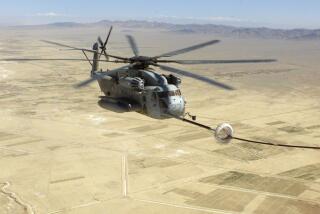Marines Take Delivery of $25-Million Hornet Jet : Aviation: All Weather Fighter Attack Squadron 242 at El Toro gets its first F/A-18D, which can carry a 17,000-pound payload.
- Share via
EL TORO — The last time that a squadron of Marine pilots at El Toro took delivery of its first $25-million Hornet jet-fighter fresh off the production line, military bands, ribbons and a formal unveiling marked the occasion.
But that was nine months ago, and Marines weren’t dying in the Gulf then.
So when All Weather Fighter Attack Squadron 242 at El Toro got the first F/A-18D Hornet to call its own on Monday, the mood was a bit more subdued and low-key.
There were speeches and cheers, but because the 3-day-old ground war in the Gulf was signaling a more dangerous role for Orange County troops, there were also frequent references to events overseas--and frustrations because the local Marines can’t be there.
“We’re going to train like we’re going into combat,” said Lt. John M. Till, 26, a Hornet pilot from San Diego. But he added quickly that the squadron realizes this may be months off--if the opportunity ever comes.
Squadron 242 will have the Hornet--a dozen in all by August--to replace the A-6E Intruder jet, an old “warhorse,” as Brig. Gen. Harry Blot, acting commander of the 3rd Air Wing (Rear), called the plane Monday.
The first squadron at El Toro to get the Hornets--the 121st--is now stationed in the Gulf, with its role as air support for ground troops made more crucial by the start of ground fighting on Saturday. The 121st got its first plane last May.
But for the 242nd, it will be at least half a year of training and probably longer before the squadron will be deployed to the Persian Gulf or anywhere else outside El Toro, squadron leaders said.
Blot said at a ceremony marking the arrival of the first Hornet that the squadron will be ready if and when the time comes for it to do battle.
But in reference to the apparent success and speed of the ground war, he told squadron members: “The way things are going right now, you’re not going to get trained in time.”
Squadron members maintained that the start of the ground war has had little effect on their mood or training.
“It’s pretty much ‘ops normal,’ ” said one pilot, using military lingo for normal operations. “We all knew that it would come to a ground war at some point, and we just want to get flying.”
Despite disappointment over not being “over there,” Lt. Col. Dan Driscoll, 40, who heads the squadron, told about 100 people that Monday marked “the start of a very long and enjoyable transition” to the F/A-18D.
Driscoll, flying solo in the twin-seat attack craft, picked the Hornet up from its McDonnell Douglas production plant in St. Louis and flew it to El Toro on Monday in about 3 1/2 hours, he said, reaching land speeds of about 480 m.p.h.
Asked afterwards by men in the squadron how the flight went, the colonel told them: “I’ve got a couple of small gripes that need to be looked at--but it’s up.”
The premier attack craft in the Marine fleet, the F/A-18D is considered superior to its predecessors for nighttime flying, utilizing controversial night-vision goggles.
Driscoll and other pilots in the 242nd said Monday that the jet offers them a package of computer-aided advances in navigation, payload delivery and other areas not previously brought together in one plane.
Fifty-six feet long, the sleek gray strike fighter was first flown in October, 1987, and can carry a payload of up to 17,000 pounds.
More to Read
Sign up for Essential California
The most important California stories and recommendations in your inbox every morning.
You may occasionally receive promotional content from the Los Angeles Times.










